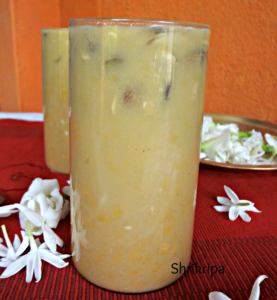Ghee residue is a moist, brown coloured, by-product formed after preparing ghee from white butter. It is a rich source of essential fatty acids, anti-oxidants and proteins.
As of now, you will know my love towards this sediment and I usually make it a point to prepare any tea cakes after making fresh homemade ghee. Usually I play with the ingredient and flavours in these cakes. Already I have Egg less Tea cake and Chocolate cake in my blog.
This time, I included cinnamon flavour in my cake by using chopped fresh apple. I have used tasteless mini apples which I took in the market for its attractive size and colour, turned out to be a tasteless apple, after cutting 😉

Now we will see how to make this,
Ingredients:
Apples – 1 cup (chopped)
Ghee residue – 2 to 3 table spoons
Sugar – ½ cup
Organic jaggery powder – ½ cup
All purpose flour – 1 cup
Whole wheat flour – 1 cup
Cinnamon – 1/2 tea spoon
Eggs – 2 (beaten)
Water – 1 cup
Cooking soda – 1 tsp or little less.
Method:
– Wash all the apples and chop it into tiny pieces. No need to remove the peel.
-Grease the baking tray (you can use bread tin as well). Line this with butter paper, keep it ready.
–In another bowl, dry mix All purpose flour, whole wheat flour, cinnamon powder and keep aside.
-Take vessel in which you prepare ghee. There will be 2-3 table spoon ghee residues.
-To this add water, chopped apples, sugar, jaggery and heat it until sugar dissolves. Switch off and cool.

-Add cooking soda and keep aside at least for 20 min.
– After it cools, add beaten eggs and mix nicely.
-Now fold in flour mixture, mix gently and pour this batter to a greased and lined baking vessel.
-Bake this in a pre- heated oven for 35 -40 min or until done at 180 C.
-If you want to check its doneness, use tooth pick or knife. Insert this, if it comes out clean, remove the tin, keep it outside.
-After some time, remove butter paper and cool further.
-When it reaches room temperature, you can slice it or cut according to your wish and enjoy with cup of coffee or tea.

Note:
-You can use only All-purpose flour or mixture of any flour.
-You can use only sugar, Jaggery or mixture of both.
-If you like it sweeter, please increase the quantity of sweet by adding ¼ cup more of sugar or jaggery.







































